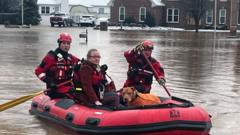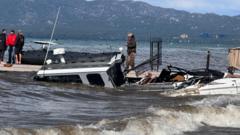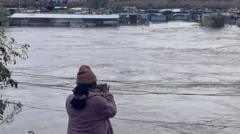This past weekend, severe storms in the southeastern United States resulted in at least 10 fatalities and left thousands stranded due to heavy flooding.
Fatal Floods Devastate Southeastern US, Claiming at Least 10 Lives

Fatal Floods Devastate Southeastern US, Claiming at Least 10 Lives
Torrential rains and flooding lead to tragic fatalities and widespread destruction across multiple states in the southeast.
The article text:
At least 10 people have tragically lost their lives as a result of severe flooding caused by torrential rains that swept through parts of the southeastern United States over the weekend. Kentucky Governor Andy Beshear confirmed that nine of the deceased were from his state, prompting him to declare a state of emergency. Nearly 1,000 individuals were reported to have been stranded by floodwaters and required rescues, as reported on Sunday.
In Kentucky, the catastrophic weather conditions were compounded by the impending threat of colder, drier weather, with meteorologists warning of potential snow and ice, as well as significant disruptions. The lone fatality outside of Kentucky occurred in Georgia, where a man was killed when an uprooted tree crashed into his home as he lay in bed.
The storm system impacted several states, including Alabama, Mississippi, Tennessee, Virginia, West Virginia, and North Carolina, which were all under various storm-related alerts. This follows extensive damage these regions sustained from Hurricane Helene in September.
The power outages caused by the storm extended to hundreds of thousands of homes, though reports indicate that this figure has decreased to tens of thousands by early Monday morning, per data from Poweroutage.us. The National Weather Service (NWS) reported that certain areas in Kentucky experienced up to 6 inches (15 cm) of rain, leading to rapid flooding and significant rises in river levels, which left vehicles submerged in water and resulted in the closure of numerous roads.
Among the victims in Kentucky were a mother and her seven-year-old child, alongside a 73-year-old man. One anxious resident from Knott County expressed his fear of losing everything again, recalling the extreme flooding he experienced two years prior.
In response to the disaster, Beshear has reached out to the White House to request federal assistance for the affected areas, which President Donald Trump approved, allowing the Federal Emergency Management Agency (FEMA) to coordinate relief efforts.
In Tennessee's Obion County, heavy rainfall caused a levee to breach, resulting in immediate and severe flooding. The town of Rives, which has a population of approximately 300, was inundated after the flood barrier failed. Emergency responders provided rescue efforts, with visuals showing swift water overtaking local landscapes. The county mayor declared a state of emergency and mandated evacuations in Rives.
Meanwhile, Governor Patrick Morrisey of West Virginia declared a state of emergency in over a dozen counties due to the severe weather. Kristi Noem, head of the Department of Homeland Security, stated her department was in communication with the governors from the affected states, emphasizing local officials should lead emergency response initiatives but assuring them that DHS is prepared to deploy resources and support swiftly.
This same storm system is now contributing to heavy snow in parts of Canada, while the NWS warns that frigid arctic air could bring record low temperatures and dangerous wind chills to central regions of the U.S. in the week ahead.
At least 10 people have tragically lost their lives as a result of severe flooding caused by torrential rains that swept through parts of the southeastern United States over the weekend. Kentucky Governor Andy Beshear confirmed that nine of the deceased were from his state, prompting him to declare a state of emergency. Nearly 1,000 individuals were reported to have been stranded by floodwaters and required rescues, as reported on Sunday.
In Kentucky, the catastrophic weather conditions were compounded by the impending threat of colder, drier weather, with meteorologists warning of potential snow and ice, as well as significant disruptions. The lone fatality outside of Kentucky occurred in Georgia, where a man was killed when an uprooted tree crashed into his home as he lay in bed.
The storm system impacted several states, including Alabama, Mississippi, Tennessee, Virginia, West Virginia, and North Carolina, which were all under various storm-related alerts. This follows extensive damage these regions sustained from Hurricane Helene in September.
The power outages caused by the storm extended to hundreds of thousands of homes, though reports indicate that this figure has decreased to tens of thousands by early Monday morning, per data from Poweroutage.us. The National Weather Service (NWS) reported that certain areas in Kentucky experienced up to 6 inches (15 cm) of rain, leading to rapid flooding and significant rises in river levels, which left vehicles submerged in water and resulted in the closure of numerous roads.
Among the victims in Kentucky were a mother and her seven-year-old child, alongside a 73-year-old man. One anxious resident from Knott County expressed his fear of losing everything again, recalling the extreme flooding he experienced two years prior.
In response to the disaster, Beshear has reached out to the White House to request federal assistance for the affected areas, which President Donald Trump approved, allowing the Federal Emergency Management Agency (FEMA) to coordinate relief efforts.
In Tennessee's Obion County, heavy rainfall caused a levee to breach, resulting in immediate and severe flooding. The town of Rives, which has a population of approximately 300, was inundated after the flood barrier failed. Emergency responders provided rescue efforts, with visuals showing swift water overtaking local landscapes. The county mayor declared a state of emergency and mandated evacuations in Rives.
Meanwhile, Governor Patrick Morrisey of West Virginia declared a state of emergency in over a dozen counties due to the severe weather. Kristi Noem, head of the Department of Homeland Security, stated her department was in communication with the governors from the affected states, emphasizing local officials should lead emergency response initiatives but assuring them that DHS is prepared to deploy resources and support swiftly.
This same storm system is now contributing to heavy snow in parts of Canada, while the NWS warns that frigid arctic air could bring record low temperatures and dangerous wind chills to central regions of the U.S. in the week ahead.



















